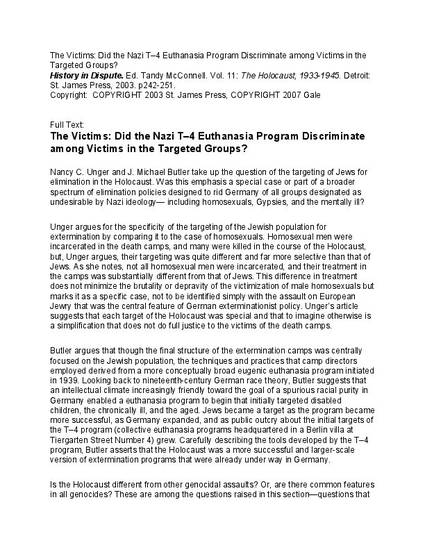
Nancy C. Unger and J. Michael Butler take up the question of the targeting of Jews for elimination in the Holocaust. Was this emphasis a special case or part of a broader spectrum of elimination policies designed to rid Germany of all groups designated as undesirable by Nazi ideology— including homosexuals, Gypsies, and the mentally ill?
Unger argues for the specificity of the targeting of the Jewish population for extermination by comparing it to the case of homosexuals. Homosexual men were incarcerated in the death camps, and many were killed in the course of the Holocaust, but, Unger argues, their targeting was quite different and far more selective than that of Jews. As she notes, not all homosexual men were incarcerated, and their treatment in the camps was substantially different from that of Jews. This difference in treatment does not minimize the brutality or depravity of the victimization of male homosexuals but marks it as a specific case, not to be identified simply with the assault on European Jewry that was the central feature of German exterminationist policy. Unger’s article suggests that each target of the Holocaust was special and that to imagine otherwise is a simplification that does not do full justice to the victims of the death camps.
Butler argues that though the final structure of the extermination camps was centrally focused on the Jewish population, the techniques and practices that camp directors employed derived from a more conceptually broad eugenic euthanasia program initiated in 1939. Looking back to nineteenth-century German race theory, Butler suggests that an intellectual climate increasingly friendly toward the goal of a spurious racial purity in Germany enabled a euthanasia program to begin that initially targeted disabled children, the chronically ill, and the aged. Jews became a target as the program became more successful, as Germany expanded, and as public outcry about the initial targets of the T–4 program (collective euthanasia programs headquartered in a Berlin villa at Tiergarten Street Number 4) grew. Carefully describing the tools developed by the T–4 program, Butler asserts that the Holocaust was a more successful and larger-scale version of extermination programs that were already under way in Germany.
Is the Holocaust different from other genocidal assaults? Or, are there common features in all genocides? These are among the questions raised in this section—questions that remain vital as contemporary society grapples with the aftermaths of genocides in many different places. Questions about history and debates about answers are crucial in understanding not only the past but also the present as well.

From . History in Dispute. © 2003 Gale, a part of Cengage Learning, Inc. Reproduced by permission.
www.cengage.com/permissions